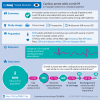In-hospital cardiac arrest in critically ill patients with covid-19: multicenter cohort study
- PMID: 32998872
- PMCID: PMC7525342
- DOI: 10.1136/bmj.m3513
In-hospital cardiac arrest in critically ill patients with covid-19: multicenter cohort study
Abstract
Objectives: To estimate the incidence, risk factors, and outcomes associated with in-hospital cardiac arrest and cardiopulmonary resuscitation in critically ill adults with coronavirus disease 2019 (covid-19).
Design: Multicenter cohort study.
Setting: Intensive care units at 68 geographically diverse hospitals across the United States.
Participants: Critically ill adults (age ≥18 years) with laboratory confirmed covid-19.
Main outcome measures: In-hospital cardiac arrest within 14 days of admission to an intensive care unit and in-hospital mortality.
Results: Among 5019 critically ill patients with covid-19, 14.0% (701/5019) had in-hospital cardiac arrest, 57.1% (400/701) of whom received cardiopulmonary resuscitation. Patients who had in-hospital cardiac arrest were older (mean age 63 (standard deviation 14) v 60 (15) years), had more comorbidities, and were more likely to be admitted to a hospital with a smaller number of intensive care unit beds compared with those who did not have in-hospital cardiac arrest. Patients who received cardiopulmonary resuscitation were younger than those who did not (mean age 61 (standard deviation 14) v 67 (14) years). The most common rhythms at the time of cardiopulmonary resuscitation were pulseless electrical activity (49.8%, 199/400) and asystole (23.8%, 95/400). 48 of the 400 patients (12.0%) who received cardiopulmonary resuscitation survived to hospital discharge, and only 7.0% (28/400) survived to hospital discharge with normal or mildly impaired neurological status. Survival to hospital discharge differed by age, with 21.2% (11/52) of patients younger than 45 years surviving compared with 2.9% (1/34) of those aged 80 or older.
Conclusions: Cardiac arrest is common in critically ill patients with covid-19 and is associated with poor survival, particularly among older patients.
© Author(s) (or their employer(s)) 2019. Re-use permitted under CC BY-NC. No commercial re-use. See rights and permissions. Published by BMJ.
Conflict of interest statement
Competing interests: All authors have completed the ICMJE uniform disclosure form at www.icmje.org/coi_disclosure.pdf and declare: support from the National Institutes of Health and the Frankel Cardiovascular Center COVID-19 Impact Research Ignitor for the submitted work; no financial relationships with any organizations that might have an interest in the submitted work in the previous three years; no other relationships or activities that could appear to have influenced the submitted work.
Figures




Comment in
-
Uncertain evolution of untreated coronary syndromes during covid-19 pandemic.BMJ. 2020 Nov 4;371:m4250. doi: 10.1136/bmj.m4250. BMJ. 2020. PMID: 33148616 No abstract available.
References
-
- Hospitals consider universal do-not-resuscitate orders for coronavirus patients Washington Post2020. https://www.washingtonpost.com/health/2020/03/25/coronavirus-patients-do....
Publication types
MeSH terms
Grants and funding
LinkOut - more resources
Full Text Sources
Medical
